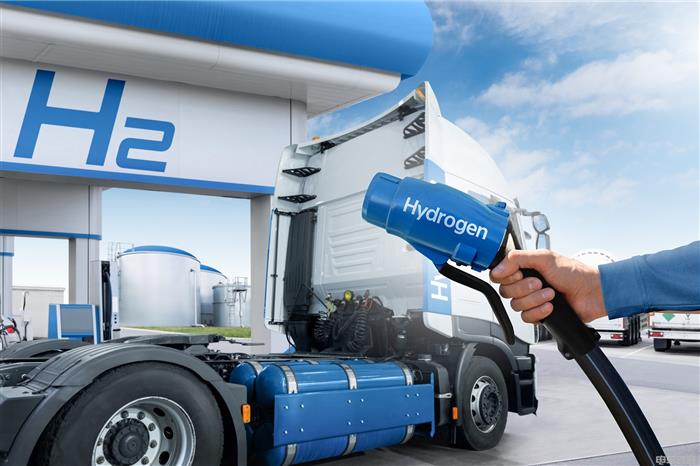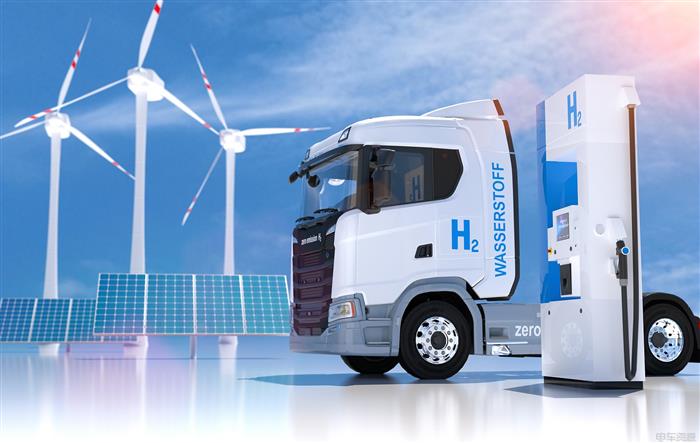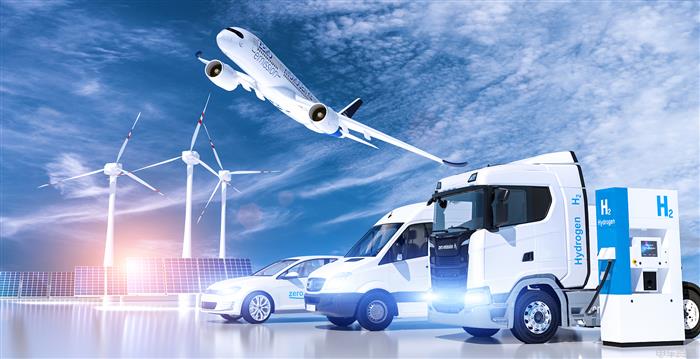United States Chooses to "Abandon" Hydrogen Fuel Cells
Recently, a statement from General Motors announcing the "termination of next-generation hydrogen fuel cell development and the cancellation of a $55 million plant construction plan" has stirred considerable waves in the global hydrogen energy industry. This is not an isolated case; previously, Stellantis Group also announced the cessation of hydrogen fuel cell technology development. What issues are exposed by the "collective retreat" of American car manufacturers from the hydrogen energy track? What differentiated path has China taken in this field? What special value do hydrogen fuel cells hold for Chinese commercial vehicles?

I. American Automakers "Hit the Brakes": The "American Dilemma" of Hydrogen Fuel Cells
It is not difficult to notice that the attitude of American car companies toward hydrogen fuel cells is undergoing a significant shift recently—there is a comprehensive contraction in the non-commercial sector, with only a small amount of exploration retained in specific commercial scenarios.
General Motors' "turnaround" has been the most thorough. A year ago, it planned to build the first independent hydrogen plant in Michigan with its partners, but the project has now officially "fallen through." A spokesperson stated that changes in policy, a lack of hydrogen infrastructure, and a reassessment of their investment portfolio are the core reasons. In an official statement, GM further clarified that while hydrogen fuel cells have potential in industrial scenarios such as backup power, mining, and heavy-duty trucks, "the path to sustainability is long and uncertain." The high costs in the U.S. and the limited hydrogen infrastructure directly limit consumer acceptance of hydrogen fuel vehicles.
It is worth noting that GM has not completely abandoned hydrogen energy but has left the remaining "spark" in the commercial vehicle sector—through its joint venture with Honda, producing hydrogen fuel cells at the Brownstown plant exclusively for commercial mining and heavy-duty trucks. Behind this decision is its firm confidence in the future of electric vehicles and a complete skepticism towards the civilian use of hydrogen fuel.
Coincidentally, this summer, Stellantis Group also announced the termination of its hydrogen fuel cell research and development program. The statement from its Chief Operating Officer for Europe, Jean-Philippe Imparato, is quite representative: “In the context of Europe's strict carbon dioxide regulations, the hydrogen market remains a niche area with no medium-term economic sustainability prospects.” Ultimately, Stellantis has chosen to concentrate its resources on electric and hybrid passenger vehicles, as well as light commercial vehicles.
The predicament of the hydrogen fuel cell industry in the United States is more apparent from the data: by 2024, the U.S. will have only 54 public hydrogen fuel stations, almost all of which are concentrated in California. The situation in the UK is even worse, with only 15 hydrogen stations. The "isolation" of infrastructure makes it difficult for hydrogen fuel vehicles to become widespread—in addition to California, it is extremely difficult to purchase hydrogen fuel vehicles in other regions of the United States.
The "swing" in policy support further disheartens companies. Previously, the Biden administration passed the Inflation Reduction Act, approving two grants totaling $52 million for General Motors to develop fuel cell manufacturing systems and hydrogen fuel trucks. However, the Trump administration recently proposed canceling this funding. In March 2024, the U.S. Department of Energy had allocated $30 million to General Motors' hydrogen project, but General Motors disclosed that it "never received this money."
Of course, a few companies are still persisting: BMW is maintaining its BMW iX5 pilot fleet, planning to launch hydrogen-powered vehicles for customers between 2025 and 2030; Toyota has already launched its first hydrogen fuel car for consumers. However, overall, the "civilianization path" of the hydrogen fuel cell industry in the United States has basically been put on "pause."

China's Hydrogen Energy Path: Avoiding the "American Pit" and Following Its Own Route
The "withdrawal" of the United States does not mean that the hydrogen energy sector has lost its value. Based on its own energy structure and industrial needs, China has adopted a differentiated approach of "policy guidance + infrastructure first + full industry chain layout," avoiding the core dilemmas faced by the United States.
1. Policy: From "top-level design" to "implementation details," the direction is clear.
China has long incorporated hydrogen energy into its strategic planning: The "14th Five-Year Plan" clearly states "to explore the application of clean energy such as hydrogen energy." The "Medium and Long-term Plan for the Development of the Hydrogen Energy Industry (2021-2035)" released in 2022 explicitly identifies hydrogen energy as "an important component of the future national energy system" for the first time. Subsequently, various regions have introduced local measures, such as Guangdong proposing to "build more than 300 hydrogen refueling stations by 2025" and Shanghai emphasizing the "focus on developing hydrogen fuel commercial vehicles."
Unlike the "fluctuating" policies of the United States, China's hydrogen energy policies are highly consistent—they set long-term goals (establishing a hydrogen energy industry system by 2035) and also have short-term implementation measures (such as demonstration city clusters for hydrogen fuel cell vehicles), providing companies with stable development expectations.
Infrastructure: Breaking Down "Islands" to Build a National Network
In response to the issue of "few and concentrated hydrogen refueling stations" in the United States, China is accelerating the construction of hydrogen refueling stations with a more balanced layout. By the end of 2024, the number of hydrogen refueling stations in China is expected to exceed 350, far surpassing the United States. More importantly, these refueling stations are not concentrated in a single region but are distributed along industrial belts such as the Yangtze River Delta, Pearl River Delta, and Bohai Rim. For instance, in cities like Foshan in Guangdong, Lingang in Shanghai, and Qingdao in Shandong, "hydrogen station clusters" have formed, supporting the cross-regional operation of hydrogen fuel vehicles.
At the same time, China is also exploring new models such as "integrated oil and hydrogen stations" and "wind-solar hydrogen storage integrated stations." For instance, they are adding hydrogen refueling equipment to existing gas stations to reduce construction costs. Additionally, by using wind and photovoltaic power plants to produce hydrogen, they are achieving a "hydrogen production-storage-refueling" closed loop, which not only addresses the hydrogen supply issue but also enhances the utilization rate of infrastructure.
3. Technology: Focus on "Green Hydrogen" and Break Through Core Links
In the United States, the high cost of hydrogen fuel is largely due to the high proportion of "gray hydrogen" (hydrogen produced from fossil fuels, which is costly and has carbon emissions). China, on the other hand, has clearly defined a technology route dominated by "green hydrogen"—producing hydrogen through the electrolysis of water using renewable energy sources such as wind and solar power. This approach not only reduces carbon emissions but also allows China to leverage its advantages in the new energy sector (with global leadership in photovoltaic and wind power capacity) to control the cost of hydrogen production.
In addition, China has made continuous breakthroughs in hydrogen storage, hydrogen transportation, and core components of fuel cells (such as membrane electrodes and bipolar plates): the localization rate of high-pressure hydrogen storage tanks has increased to over 80%, liquid hydrogen storage technology has entered the pilot phase, and the cost of fuel cell systems has decreased by more than 40% compared to 2020, gradually addressing the "bottleneck" issues.

3. Commercial Vehicles: The "Value Anchor" and "Sustainability Code" of China's Hydrogen Fuel Cells
If American car manufacturers pin their hopes for hydrogen fuel cells on commercial vehicles, China has turned commercial vehicles into the "key battlefield" for the deployment of hydrogen fuel cells. This is not only because the demand scenarios for commercial vehicles highly align with the advantages of hydrogen fuel cells, but also due to the dual sustainable value embodied in the "industrial driving + dual carbon goals."
1. Application value: addressing the "core pain points" of commercial vehicles
The core demands of commercial vehicles (especially heavy trucks, long-distance buses, and port logistics vehicles) are "long range, fast refueling, and high payload capacity," which are precisely the advantages of hydrogen fuel cells.
The range is longer than electric: Hydrogen fuel cell heavy trucks can achieve a range of over 1,000 kilometers, far exceeding that of pure electric heavy trucks (generally within 500 kilometers), meeting the needs of long-haul transportation.
Hydrogen fuel cell vehicles can be refueled in about 30 minutes, which is similar to gasoline vehicles, while pure electric heavy trucks require 4-6 hours to charge, significantly impacting operational efficiency.
The load capacity is superior to electric: the battery weight of pure electric heavy trucks can reach 5-8 tons, reducing the cargo capacity; hydrogen fuel cell systems are lighter, having less impact on load capacity, making them particularly suitable for heavy load scenarios such as mining areas and ports.
Currently, hydrogen fuel commercial vehicles in China have been deployed in multiple scenarios: for example, hydrogen fuel heavy trucks at Tianjin Port carrying out container transfer tasks; hydrogen fuel buses in Foshan, with an operating mileage exceeding one million kilometers; and hydrogen fuel mining trucks in Shanxi, achieving zero-emission transport in coal mining areas.
2. Sustainability: From "Industry Driven" to "Dual Carbon Contribution"
The application of hydrogen fuel cells in the commercial vehicle sector is not a "single-point attempt," but rather can drive the sustainable development of the entire industry chain.
Driving the entire hydrogen energy industry chain: The large-scale application of commercial vehicles will generate significant demand for hydrogen, which in turn will promote the reduction of green hydrogen manufacturing costs (scale effect), while also driving the development of hydrogen refueling stations, hydrogen storage equipment, fuel cell components, and other industries, forming a positive cycle of "demand-supply-cost reduction."
Supporting the dual carbon goals: Commercial vehicles are major contributors to carbon emissions, especially heavy trucks, which account for only 2% of the vehicle ownership but contribute over 20% of automotive carbon emissions. Replacing fuel with hydrogen fuel cells, particularly using green hydrogen, can achieve zero emissions throughout the entire lifecycle, which is crucial for achieving the goals of "peak carbon by 2030 and carbon neutrality by 2060."
Ensuring energy security: China's dependence on imported crude oil exceeds 70%, and the extensive use of fuel in commercial vehicles exacerbates energy security pressure. Green hydrogen, on the other hand, is produced from water and can be generated using renewable energy, making it a "domestic energy" source. Developing hydrogen fuel commercial vehicles can reduce reliance on imported crude oil and enhance energy autonomy and controllability.

American car companies' "abandonment" of hydrogen fuel cells essentially stems from their inability to overcome the multiple challenges of infrastructure, cost, and policy in civilian applications. In contrast, China has identified a "practical application" and "sustainable space" for hydrogen fuel cells through clear strategic planning, balanced infrastructure layout, and a focus on commercial vehicle application pathways.
In the future, as the cost of green hydrogen continues to decrease, the hydrogen refueling station network continues to improve, and fuel cell technology keeps breaking through, hydrogen fuel commercial vehicles are expected to become the "breakthrough point" for China's hydrogen energy industry, promoting the zero-carbon transformation in the transportation sector and providing a "Chinese solution" for the global hydrogen energy development.
【Copyright and Disclaimer】The above information is collected and organized by PlastMatch. The copyright belongs to the original author. This article is reprinted for the purpose of providing more information, and it does not imply that PlastMatch endorses the views expressed in the article or guarantees its accuracy. If there are any errors in the source attribution or if your legitimate rights have been infringed, please contact us, and we will promptly correct or remove the content. If other media, websites, or individuals use the aforementioned content, they must clearly indicate the original source and origin of the work and assume legal responsibility on their own.
Most Popular
-

Wave of Chemical Plant Shutdowns Spreads Across Europe! Dow, INEOS, and Trinseo Shut Down Again! The Plastic Market Is in the Red
-

Join the K Exhibition Feast | 2025 Mold-Masters Latest Technology Highlights Quick Dispatch
-

Wuhu Baolvt Focuses on Plastic Recycling Technology: Modified Recycled HDPE, Promoting the Implementation of the Circular Economy
-

List Released! Mexico Announces 50% Tariff On 1,371 China Product Categories
-

Focusing on K 2025 in Germany: Lubrizol Unveils Next-Generation TPU Technology






